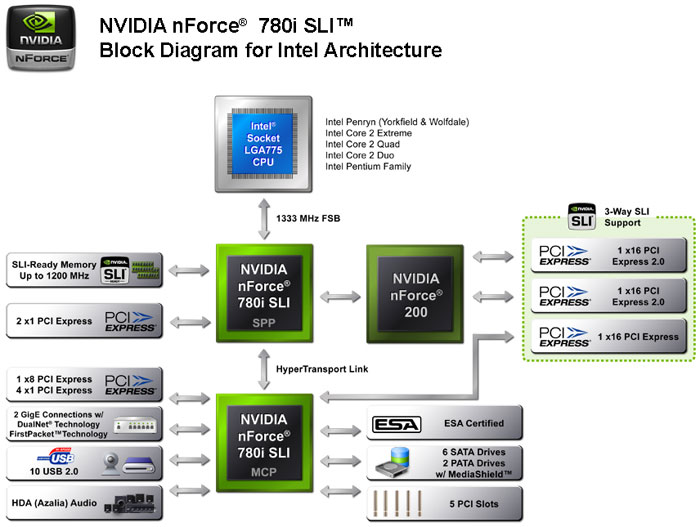Page 2 - Specifications & Technology
So the product we'll be testing today is the flagship enthusiast targeted Intel processor mainboard. It's based on the nForce 780i (with an i for Intel) SLI chipset and the product as tested today comes from the good people at XFX. The product is based on a 6 layer PCB; NVIDIA's own design and consists of three discrete chips, both known the 780i MCP and the 780i SPP, also called North and South bridge's as is more commonly accepted. The third being the tiny nForce 200 chip. The NVIDIA nForce 200 chip is nothing more than a PCI Express switch chip with one upstream port and up to four downstream ports allowing all your PCIe functionality at full or if preferred less bandwidth (4x8 PCIe lanes)...
The SPP and MCP are fabricated on TSMC's 90nm process technology. The new chipset brings support for the latest Socket 775 processors from Intel:
- Quad Core Yorkfield & duo core Wolfdale (45nm Penryn)
- Current (Kentsfield) Quad core & Duo Core processors (Conroe 65nm)
- All LGA775 Pentium processors
The one exception for the new 45nm products is Intel's 1600 MHz FSB flagship product QX9770 Yorkfield processor, officially it's not supported. We however had this CPU (Intel engineering Sample) available, tried it... and after two simple BIOS tweaks it worked straight out of the box, despite NVIDIA not being rather enthusiastic about that.
That alone is reason enough for me to continue the test as yes, I am Dutch and yes... therefore rather stubborn :)
We'll test the QX9770 processor in this review. This is an Intel engineering sample processor though, so that doesn't mean that the final product will work, be warned about this. But honestly, the nForce 780i can manage a 1600 MHz FSB quite easily so there's no real reason not to try it out. From another point of view, I'd suggest the Core 2 Extreme Quad Core QX9650 anyway, a little cheaper and it can overclock to 4 GHz so darn easily (read our review here).
With the release of 3-way SLI (preview here) NVIDIA wanted to make sure that the third card used now also has full x16 PCIe lanes available (on 680i the middle PCIe was a x8 slot). So effectively nForce 780i now has three PCIe x16 slots bringing you the maximum bandwidth available. Two are PCIe 2.0 and connected to the SPP, the third (middle slot) is PCIe 1.0 and is being pulled from the MCP Southbridge).

Some key features include:
- FSB speeds of 1333 MHz can be achieved with a CPU that supports this specification.
- DDR2 speeds of DDR2-1200 and beyond can be used to keep pace with overclocked system components with full support for SLI-Ready memory (EPP)
- NVIDIA nTuneM Utility Updated - allows adjustment of CPU and memory speeds without rebooting. There is also access to most BIOS settings from inside Windows.
- 3x16 PCI Express SLI Support provided by three full-bandwidth, 16-lane PCI Express links. Third PCIe Slot for Graphics Expansion to three-way SLI.
- NVIDIA MediaShieldTM Storage includes RAID and SATA drive support.
- Multiple Disk Setup Through a wizard-based interface, you can set up your drives for better data protection, faster disk access or maximum storage capacity. MediaShield automatically selects a RAID 0, 1, 0+1 or 5 configuration according to your needs. Advanced users can access RAID options directly.
- DiskAlert System In the event of a disk failure, MediaShield users see an image that highlights which disk has failed to make it easier to identify, replace, and recover.
- RAID Morphing MediaShield allows users to change their current RAID setup to another configuration in a one-step process called morphing. This eliminates the need to back up data and follow multiple steps in the process.
- Bootable Multidisk Array MediaShield storage fully supports the use of a multi-disk array for loading the operating system at power-up.
- Six SATA 3Gb/s Drives Combine up to six SATA drives into one volume for bigger, faster RAID. Drives can be configured as six RAID 0 (striped) drives for maximum throughput, or Single or Dual RAID 5 arrays. Hot plug and Native Command Queuing are supported.
- Networking with Dual Gigabit Ethernet with Teaming allows the two connections to work together to provide up to twice the Ethernet bandwidth.
- High Definition Audio (HDA) can deliver 192 kHz/32-bit quality for eight channels.
- USB 2.0 plug-and-play interface that provides easy-to-use connectivity for up to 10 USB devices.
Also a new feature that I really only figured out yesterday while torturing a CPU, there is a CPU thermal diode LED, located next to the CPU fan pins. It turns red when abnormal CPU heat is detected.

The nForce 780i SLI block diagram. As you can see that's quite a colorful palette of functionality and options, it's pretty close to the 680i though. Let's chat a little about some of the more interesting features. Next page please.
